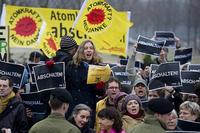-
Nuclear power stations launches emergency operations center
The new 12,000 square-foot facility at the Beaver Valley Power Station supports overall management of activities related to maintaining public health and safety during the emergency at the plant
-
-
Companies team up to develop carbon capturing
Three companies have teamed up to build a low-carbon, coal-based power plant in Scotland; the plant will include a carbon-capture and storage; with more than 90 percent carbon capture, the coal feedstock plant will generate extremely low-carbon electric power and also produce hydrogen gas for commercial use
-
-
The Transboundary Agreement is not just about the cost of gas and the environment
The Transboundary Agreement, which the United States and Mexico reached on 20 February, regulates oil and gas development in the Gulf of Mexico; before the agreement is ratified, there is a need to address serious security issues related to building more oil rigs in the Gulf – for example, the fact that the Mexican government cannot control its powerful criminal organizations, and that it will be easy for terrorists in a small boat to overrun one of these deepwater rigs
-
-
A long-term low carbon energy strategy is essential for a prosperous U.K.
An urgent remodeling of the U.K. energy infrastructure is vital if the country wants to decarbonize without “the lights going out” and not be reliant on imported energy supplies, says a new report
-
-
Researchers develop record-breaking plastic solar cell
Researchers at the University of California, Los Angeles (UCLA) have made a breakthrough with plastic solar cells, creating a record-breaking polymer cell that converts 10.6 percent of the sun’s energy into electricity
-
-
Pepco buys solar competition prize-winning building for display
WaterShed, a prize-winning, energy-saving house designed by a team from the University of Maryland, has been bought by Pepco; the utility will maintain the building and open ot for public display
-
-
Study tracks safety of underground CO2 storage
An international team of geoscientists show that carbon dioxide can safely be stored underground in depleted natural gas fields; fhe experiment, in the Otway basin near Melbourne, Australia, is the most heavily monitored project for CO2 storage in the world
-
-
Germany to scrap nuclear power by 2022

Germany yesterday announced plans to become the first major industrialized power to shut down all its nuclear plants in the wake of the disaster in Japan; phase-out due to be wrapped up by 2022; it means that the country will have to find the 22 percent of its electricity needs currently covered by nuclear reactors from another source; Monday decision is a U-turn for Chancellor Angela Merkel, and means that the current government has adopted the timetable for a nuclear phase-out set by the previous Social Democrat-Green coalition government a decade ago; it also cancels Merkel’s decision from November 2010 to extend the lifetime of Germany’s seventeen reactors by an average of twelve years, which would have kept them open until the mid-2030s
-
-
Germany ends nuclear program
Last Thursday German chancellor Angela Merkel declared that her government plans to close its nuclear power plants in a “measured exit”; the decision to end Germany’s nuclear power program was a result of the continuing nuclear crisis in Japan; some believe that Chancellor Merkel’s announcement is driven more by politics than safety concerns; recent polls show that 80 percent of voters are opposed to nuclear power; Merkel’s party faces close regional elections in states where nuclear plants are located; Switzerland, Venezuela, and China have also announced that they will suspend or delay plans to build new nuclear plants
-
-
U.S. nuclear program under greater scrutiny
The ongoing nuclear crisis in Japan has caused countries around the world to reconsider its nuclear plans; Germany recently announced that it was ending its nuclear program, while Sweden, Venezuela, and China have all announced that they were temporarily suspending their nuclear programs to conduct safety reviews; lawmakers and engineers in the United States are also pushing for greater scrutiny of nuclear power plants; in its latest report the Union of Concerned Scientists sharply criticized the U.S. Nuclear Regulatory Commission (NRC) for not properly enforcing safety regulations at nuclear power plants;
-
-
Oil industry creates center for off-shore safety
Following several accidents on off-shore oil rigs, the U.S. oil and gas industry will launch a center dedicated to investigating safety issues related to off-shore drilling; the center will be operated by the American Petroleum Institute (API) but will be walled off from the trade group’s lobbying work
-
-
Growth of geothermal energy market lags behind wind and solar
According to a recently released report, the geothermal energy market is expected to grow over the next twenty years, but will still trail far behind wind and solar; currently only twenty-six countries in the world use geothermal energy to generate power, and as of 2010 there was a total global capacity of 10,715 megawatts; in June 2010, total global capacity of wind-powered generators was 175 gigawatts; by 2020 as much as 14.4 gigawatts of new geothermal capacity will be added at a 3 percent annual growth rate; the market value is estimated to be $6.8 billion by 2020; the expansion of geothermal energy still faces several impediments; at least 350 projects currently underway face financing, drilling rig, and skilled labor shortages
-
-
Growing worries about security of Suez Canal

More than 35,000 ships crossed the Suez in 2009, about 10 percent of them oil tankers; if the Suez Canal were to close, oil tankers would be forced to sail around southern Africa — adding some 6,000 miles to the journey; this translates to an extra twelve days traveling from Saudi Arabia to Houston; based solely on speculation and risk, experts say the price of crude oil has gone up $5.00 a barrel since Friday; U.S. officials keep silent about how the United States might respond if Egyptian officials could no longer guarantee safe passage for the tens of thousands of ships that pass through the canal each year
-
-
U.S. lacks infrastructure to increase use of ethanol fuel
Scientists at Purdue University say the United States lacks the infrastructure to meet the federal Renewable Fuel Standard with ethanol; researchers say the United States has hit the “blending wall” and lacks the ability to consume more ethanol than what is currently produced; less than 3 percent of vehicles on the road are equipped to handle ethanol fuels and there are only 2,000 pumps; the federal Renewable Fuel Standard requires nearly three times as much renewable fuel to be produced per year by 2022
-
-
Army seeks to go off the grid at Fort Bliss
At Fort Bliss Army commanders seek to power the base using renewable power sources by 2015; plans include using solar, wind, geothermal, and biomass; military bases around the country are increasingly looking at renewable energy to reduce their carbon footprint and avoid disruption in the event of a terrorist attack
-
- All
- Regional
- Water
- Biometrics
- Borders/Immig
- Business
- Cybersecurity
- Detection
- Disasters
- Government
- Infrastructure
- International
- Public health
- Public Safety
- Communication interoperabillity
- Emergency services
- Emergency medical services
- Fire
- First response
- IEDs
- Law Enforcement
- Law Enforcement Technology
- Military technology
- Nonlethal weapons
- Nuclear weapons
- Personal protection equipment
- Police
- Notification /alert systems
- Situational awareness
- Weapons systems
- Sci-Tech
- Sector Reports
- Surveillance
- Transportation
Advertising & Marketing: advertise@newswirepubs.com
Editorial: editor@newswirepubs.com
General: info@newswirepubs.com
2010-2011 © News Wire Publications, LLC News Wire Publications, LLC
220 Old Country Road | Suite 200 | Mineola | New York | 11501
Permissions and Policies
Editorial: editor@newswirepubs.com
General: info@newswirepubs.com
2010-2011 © News Wire Publications, LLC News Wire Publications, LLC
220 Old Country Road | Suite 200 | Mineola | New York | 11501
Permissions and Policies
